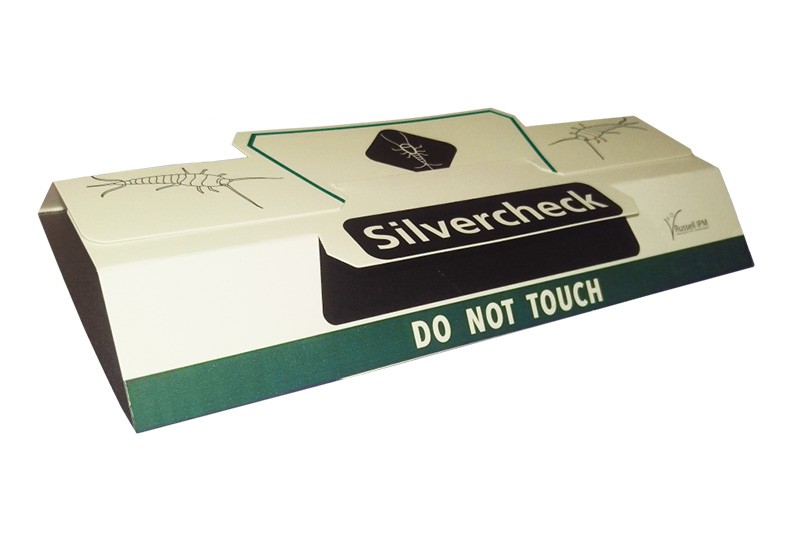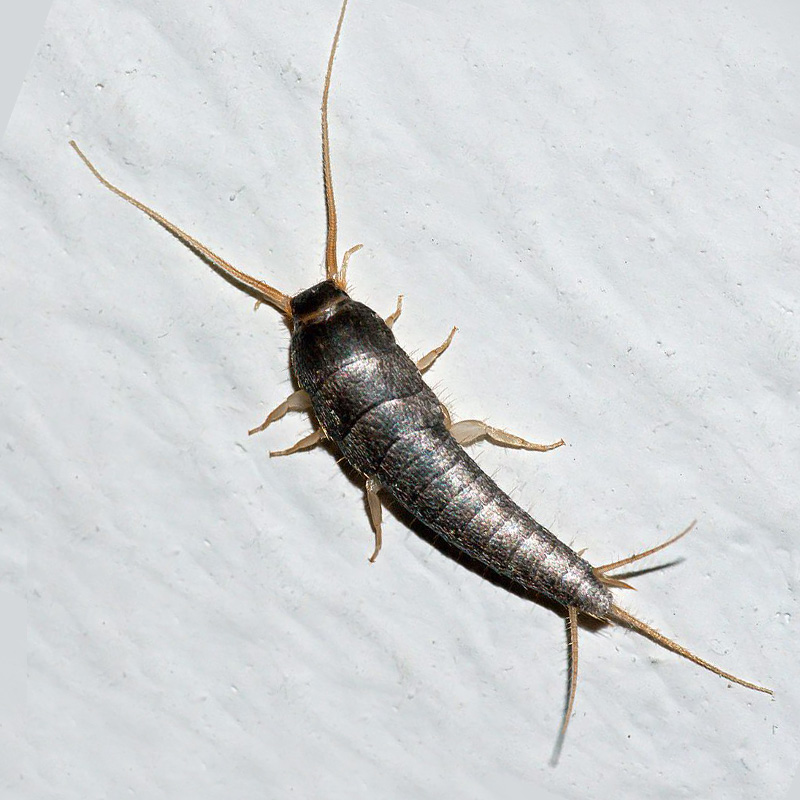
The only trap on the market that monitors both Silverfish and Grey Silverfish
Silverfish, firebrats and grey silverfish are worldwide pests of domestic dwellings and storage areas. All species inhabit damp, dark places. However, whilst the common silverfish are restricted to damp conditions, the grey silverfish can inhabit a much wider humidity range, so may be found throughout domestic dwellings and storage areas, rather than solely in damp areas. Grey silver fish are increasing in prevalence now that more homes have central heating. Firebrats are more prevalent in hot climates where temperatures reach or exceed 36 ̊C / 96.8 ̊F.
Silverfish, firebrats and grey silverfish cause damage to a variety of materials found in domestic and storage environments that contain high levels of carbohydrates and proteins. They may feed on the glue behind wallpaper or in book bindings, paper, cereals, dried meats, silks and synthetic fabrics.
British Pest Control Association
Keele University. “The Grey Silverfish | BPCA Digital Forum 5 – Your digital pest event (October)” Oct 2020
Presented by Melvin Knapp, Killgerm.
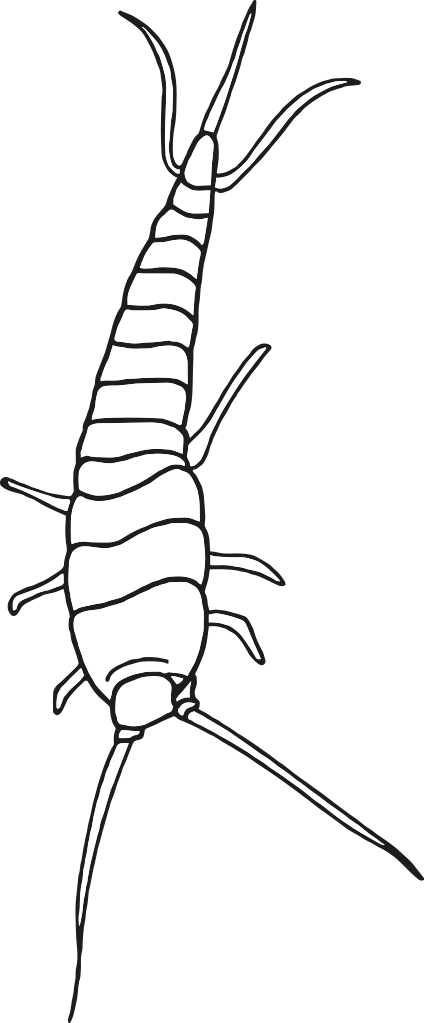
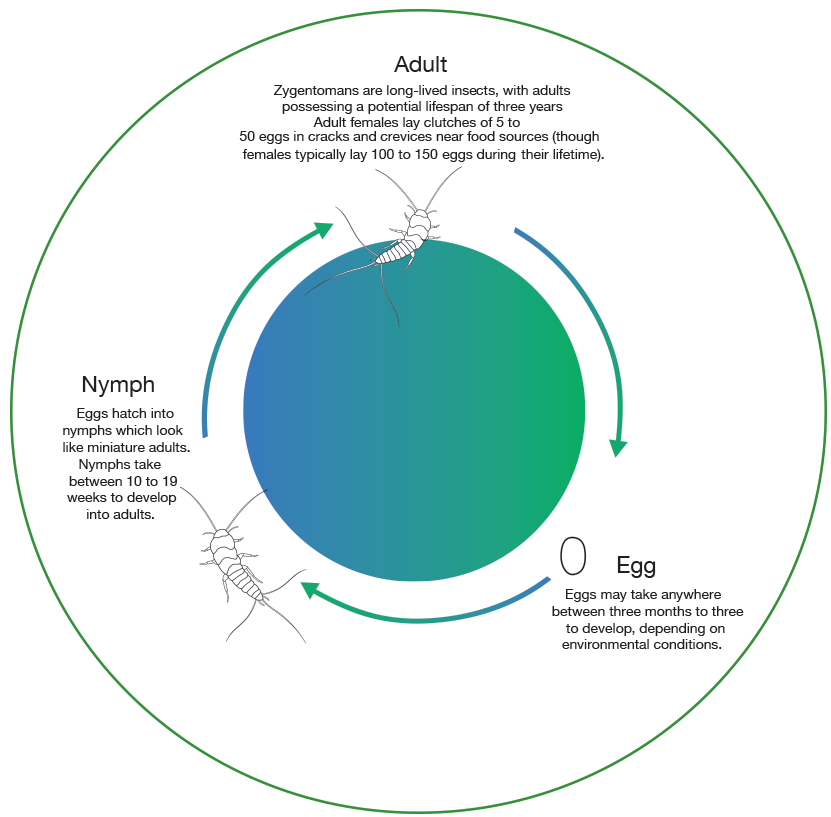
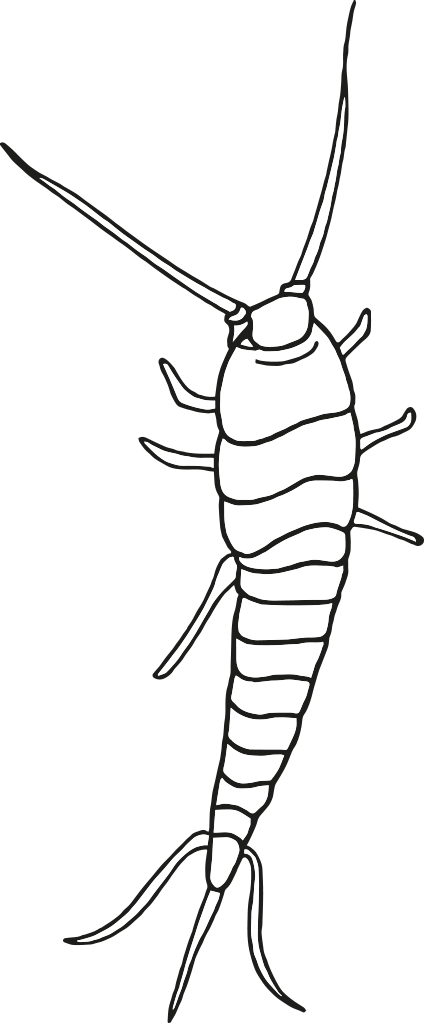
Formidable performance, discreet, easy to use.
High in demand, the Silvercheck catches three times as many common silverfish Lepisma saccharina and grey silverfish Ctenolepisma longicaudata compared to a range of commercial traps tested. This ready to use, discreet trap is a self-contained cardboard station with a powerful sticky base and unique lure.
Why use Silvercheck?
The Silvercheck lure is made up of special ingredients that are proven to be irresistible to both silverfish and grey silverfish. The trap is made from high quality cardboard with wings over the centre window to keep out dust and provide air flow to dispense the powerful attractant. It is designed with multiple entry points to allow easy access and trapping of all sizes of the silverfish species.
Benefits
- Designed with an irresistible lure to capture both silverfish and grey silverfish
- Three times more effective than other traps tested
- Attractant individually packed so it stays fresh until use Insecticide free and non-toxic
- Designed to be discreet and can be slid under equipment, furniture, in tight corners and behind objects e.g. cabinets, desks and closets.
- Multiple entry points for silverfish and grey silverfish
- High quality cardboard with wings over the centre window to keep out dust and provide air flow to disperse attractant
- Double-sided tape on the back for firm wall attachment or placement around skirting boards and coving
The Silvercheck can be used in any domestic or public building. The traps are most popularly used in rooms such as kitchens/bathrooms/basements in student accommodation and nursing homes, because silverfish thrive in these types of old buildings.
For effective results, the Silvercheck should be placed near cracks and crevices e.g. behind wallpaper, in areas where silverfish/grey silverfish like to hide. Position one trap every 25 square metres or more if you wish to pinpoint an infestation.
Tip – The double-sided tape on the back of the device allows you to attach the Silvercheck to vertical surfaces like walls and skirting boards if preferred to the floor.
Replace every 6-8 weeks unless the trap is full earlier.
The Silvercheck can be stored in a cool dry place for up to 24 months, as the lure is sealed in a separate sachet to stay fresh until use.
Grey silverfish is an increasing threat
Unlike the common silverfish, the grey silverfish have adapted to live in more arid environments, so are an increasing problem in warmer modern houses with central heating. Grey silverfish are now widespread, causing substantial stress for home and business owners. The Silvercheck lure attracts both species.
Silverfish feed on starches, sugar, proteins and fat which makes them a harmful pest of household possessions, such as books and their bindings, wallpaper, paint, photographs, breadcrumbs, cereals and cotton, even hair and dead insects. They are night-dwellers and very fast moving making them very difficult to detect. The common silverfish inhabit damp, dark areas such as your bathroom, kitchen, garage, attic or cellar. They can be found under wallpaper, flooring, behind appliances, cardboard boxes, damp clothing and paper. The grey silverfish are often detected in modern buildings and, although they prefer humid environments, they can survive in drier areas, in rooms with no running water or drains.
Grey silverfish is an increasing threat
BPCA (British Pest Control Association)
PestWatch: Silverfish and grey silverfish
A new species of silverfish has been found in the UK
is this an explanation for treatment difficulties, due to misidentification?
Nature Now! – Chris Egnoto
“Learn Something About Silverfish!”July 2018
Animal Fact Files
“Silverfish facts: Minecraft Hostiles | Animal Fact Files” May 2018
Long-tailed silverfish (Ctenolepisma longicaudata) Biology and Control
Authors:Anders Aak, Bjørn Arne Rukke, Preben S. Ottesen, Morten Hage
Published by the Norwegian Institute of Public Health Division for Infection Control and Environmental Health Department of Pest ControlMarch 2019
Citation: Aak A, Rukke BA, Ottesen PS, Hage M. 2019. Long-tailed silverfish (Ctenolepisma longicaudata) – biology and control. Oslo: Norwegian Institute of Public Health – www.fhi.no
Order: The report can be downloaded as pdf on the NIPH website: www.fhi.no
Abstract The Norwegian Institute of Public Health (NIPH) has written this document in cooperation with Norsk Hussopp Forsikring, and it summarizes the level of knowledge in 2019 regarding the long- tailed silverfish (Ctenolepisma longicaudata). NIPH acts under the Health and Care Ministry of Norway as a national competence institution for governmental authorities, the health service, the judiciary, prosecuting authorities, politicians, the media and the public independent of commercial interests. The principle of substitution is a recurring theme in the management of and research on urban pests in Norway. It states that preventive and control measures must be carried out in an efficient way, but also pose the least possible harm on human health and the environment. Therefore, it is imperative to promote least-toxic methods as an alternative to pesticide use in indoor environments it is indeed an important public health topic. The Department of Pest Control at NIPH is the national competence centre for prevention and control of indoors pests.
SILVERFISH & FIREBRATS
Richard M. Houseman, Associate Professor, Entomol- ogy Program, Division of Plant Sciences, is a State Urban Entomology Extension Specialist.
Issued in furtherance of Cooperative Extension Work Acts of May 8 and June 30, 1914, in cooperation with the United States Department of Agriculture. Michael D. Ouart, Director, Cooperative Extension, University of Missouri, Columbia, MO 65211. University of Missouri Extension does not discriminate on the basis of race, color, national origin, sex, sexual orientation, religion, age, disability or status as a Vietnam era veteran in employment or programs. If you have special needs as addressed by the Americans with Disabilities Act and need this publication in an alternative format, write ADA Officer, Extension and Agricultural Information, 1-98 Agriculture Building, Columbia, MO 65211, or call 573-882-7216. Reasonable efforts will be made to accommodate your special needs.
Silverfish and firebrats (also called bristletails) belong to the insect order Thysanura. Three spe- cies of silverfish, Lepisma saccha- rina, Ctenolepisma longicaudata and Ctenolepisma quadriseriata, and one species of firebrat, Thermobia domes- tica, are the important house-dwell-ing bristletails in North America (Figure 1). Some of the differences between these species are shown in Table 1. All bristletails are carrot- shaped, somewhat flattened, and covered with grayish scales. They have long, slender antennae and three slender appendages at the rear of the body. They are wing- less and do not fly. However, they move quickly, often stopping for short intervals and then rapidly moving on.
SILVERFISH SILK IS FORMED BY ENTANGLEMENT OF RANDOMLY COILED PROTEIN CHAINS
Andrew A. Walker a, b, Jeffrey S. Church c, Andrea L. Woodhead c, Tara D. Sutherland b, *
a Research School of Biology, Australian National University, Canberra, ACT 0200, Australia b CSIRO Ecosystem Sciences, Canberra 2601, Australia
c CSIRO Materials Science and Engineering, Waurn Ponds, Victoria 3216, Australia
Article history:
Received 22 November 2012 Received in revised form
25 March 2013
Accepted 26 March 2013
Abstract –
Silks are semi-crystalline solids in which protein chains are associated by intermolecular hydrogen bonding within ordered crystallites, and by entanglement within unordered regions. By varying the type of protein secondary structure within crystallites and the overall degree of molecular order within fibers, arthropods produce fibers with a variety of physical properties suited to many purposes. We charac- terized silk produced as a tactile stimulus during mating by the grey silverfish (Ctenolepisma long- icaudata) using Fourier transform infrared spectroscopy, polarized Raman spectroscopy, gel electrophoresis and amino acid analysis. Fibers were proteinaceousdthe main component being a 220 kDa proteindand were rich in Gln/Glu, Leu, and Lys. The protein structure present was predomi- nantly random coil, with a lesser amount of beta-structure. Silk fibers could readily be solubilized in aqueous solutions of a mild chaotrope, sodium dodecyl sulfate, indicating protein chains were not cross- linked by disulfide or other covalent bonds. We conclude that entanglement is the major mechanism by which these silk proteins cohere into a solid material. We propose silks used as short-term tactile cues are subject to less stringent requirements for molecular order relative to other silks, allowing the random coil structure to be favored as an adaptation promoting maximal entanglement and adhesion.
UTILIZATION AND EXCRETION OF ORGANIC NITROGEN BY THE SILVERFISH, C’TENOLEPISMA LINEATAS
Ins. Physiol.,1959, Vol.3, pp. 86 to 91. Pergamon Press Ltd.,London. printed in Great Britain
REUBEN LASKER*
Department of Siological Sciences, Stanford University, Stanford, California
(Received 18July 1958)
Abstract-Conversion efficiencies of organic nitrogen to live weight have been deter- rained for the silverfish, Ctenokpisma Zineuta. These efficiencies vary from 0.014 to O-13 mg N/mg live weight between animals and vary similarly within the same animal depending on the diet. The rate of weight gain by animals feeding on a complete diet ranged from 0.25 to O-67 mg live weight per week. The silverfish can also live for extended periods on a diet of cellulose alone but requires a source of organic nitrogen for growth and other vital processes. Conservation of nitrogen seems to be accom- plished by an inherent low turnover of tissue nitrogen when the animal is metabolizing carbohydrates. C. &euta may lose from 8 to 20 per cent of its total body nitrogen before expiring.
Abstract –
Silks are semi-crystalline solids in which protein chains are associated by intermolecular hydrogen bonding within ordered crystallites, and by entanglement within unordered regions. By varying the type of protein secondary structure within crystallites and the overall degree of molecular order within fibers, arthropods produce fibers with a variety of physical properties suited to many purposes. We charac- terized silk produced as a tactile stimulus during mating by the grey silverfish (Ctenolepisma long- icaudata) using Fourier transform infrared spectroscopy, polarized Raman spectroscopy, gel electrophoresis and amino acid analysis. Fibers were proteinaceousdthe main component being a 220 kDa proteindand were rich in Gln/Glu, Leu, and Lys. The protein structure present was predomi- nantly random coil, with a lesser amount of beta-structure. Silk fibers could readily be solubilized in aqueous solutions of a mild chaotrope, sodium dodecyl sulfate, indicating protein chains were not cross- linked by disulfide or other covalent bonds. We conclude that entanglement is the major mechanism by which these silk proteins cohere into a solid material. We propose silks used as short-term tactile cues are subject to less stringent requirements for molecular order relative to other silks, allowing the random coil structure to be favored as an adaptation promoting maximal entanglement and adhesion.
ULTRASTRUCTURE OF SPERMATHECAL EPITHELIUM OF CTENOLEPISMA LONGICAUDATA (INSECTA: THYSANURA)
SMITA PALIT & SANTI G. PAL (1999) Ultrastructure of spermathecal epithelium of Ctenolepisma longicaudata (Insecta: Thysanura), Invertebrate Reproduction & Development, 36:1-3, 159-162, DOI: 10.1080/07924259.1999.9652693
To link to this article: http://dx.doi.org/10.1080/07924259.1999.9652693
Published online: 01 Dec 2010.
The epithelial cells and their ultrastructural features of the Spermatheca of Ctenolepisma longicaudata have been described. In addition to the epithelial cells, both muscle and cuticular cells are also present in this organ. A variety of secretory vesicles and granules having lysosomal enzymes or mucoproteins is elaborated by the epithelial cells which are subsequently conducted to the apical cytoplasm for discharge in the lumen. Microtubules are involved in the direction of flow of secretory products. Besides, the cuticular and muscle cells of his organ of C. longicaudata make the latter exceedingly complicated for sperm storage, conduction and viability.
FUNGAL SYMBIONT OF FIREBRATS (THYSANURA) INDUCES ARRESTMENT BEHAVIOUR OF FIREBRATS AND GIANT SILVERFISH BUT NOT COMMON SILVERFISH
Nathan Woodbury, Gerhard Gries
2013 Entomological Society of Canada Downloaded from https://www.cambridge.org/core. Norges Landbrukshoegskole, on 08 Sep 2017 at 07:23:42, subject to the Cambridge Core terms of use, available at https://www.cambridge.org/core/terms. https://doi.org/10.4039/tce.2013.35
Abstract—We have recently shown that firebrats, Thermobia domestica (Packard) (Thysanura: Lepismatidae), carry, and deposit with their faeces, the symbiotic bacterium Enterobacter cloacae (Jordan 1890) Hormaeche and Edwards 1960 (Enterobacteriaceae) and the symbiotic fungus Mycotypha microspora Fenner, 1932 (Mycotyphaceae), and that these microbes induce arrestment behaviour and aggregation of firebrats. Here, we tested whether giant silverfish, Ctenolepisma longicaudata Escherich (Thysanura: Lepismatidae), and common silverfish, Lepisma saccharina (Linnaeus) (Thysanura: Lepismatidae), also arrest in response to these two microbes. In dual-choice bioassays, E. cloacae arrested firebrats but not giant silverfish or common silverfish, whereas M. microspora arrested firebrats and giant silverfish but not common silverfish. As close relatives, firebrats and giant silverfish have similar microclimate and nutrient requirements and may use M. microspora as the same aggregation cue when they aggregate in hot and humid microclimates where M. microspora proliferates and breaks down cellulose. As a more distant relative to firebrats and giant silverfish, common silverfish seem to require a different as yet unknown aggregation cue or signal, possibly one that is indicative of the type of microclimate (room temperature; high humidity) they prefer.
PHEROMONE-BASED ARRESTMENT BEHAVIOR IN THE COMMON SILVERFISH, LEPISMA SACCHARINA, AND GIANT SILVERFISH, CTENOLEPISMA LONGICAUDATA
Nathan Woodbury & Gerhard Gries
Received: 11 November 2006 / Revised: 16 April 2007 / Accepted: 25 April 2007 / Published online: 17 May 2007
Springer Science + Business Media, LLC 2007
N. Woodbury : G. Gries
Department of Biological Sciences, Simon Fraser University, Burnaby, British Columbia V5A 1S6, Canada
e-mail: gries@sfu.ca
Abstract Aggregations of the common silverfish, Lepisma saccharina, and giant silverfish, Ctenolepisma longicaudata (both Thysanura: Lepismatidae), are mediated by species-specific pheromones. In dual-choice, still-air olfactometer experiments, filter paper previously exposed to 12 male, female, or juvenile L. saccharina or C. longicaudata arrested conspecifics regardless of developmental stage or sex. Arrestment responses required physical contact with the pheromone. Insect-derived frass, scales, antennae, and setae, as well as salivary gland content, are not the source of the contact pheromone in L. saccharina. Lepisma saccharina did not respond to the pheromone of C. longicaudata, nor to that of another thysanuran, the firebrat Thermobia domestica. However, C. longicaudata responded to pheromones of both L. saccharina and T. domestica, whereas T. domestica responded to the C. longicaudata but not L. saccharina pheromone. These results support the hypothesis that a closer phylogenetic relationship exists between C. longicaudata and T. domestica than between C. longicaudata and L. saccharina, but a definitive conclusion must await molecular genetic analyses of all three species.


